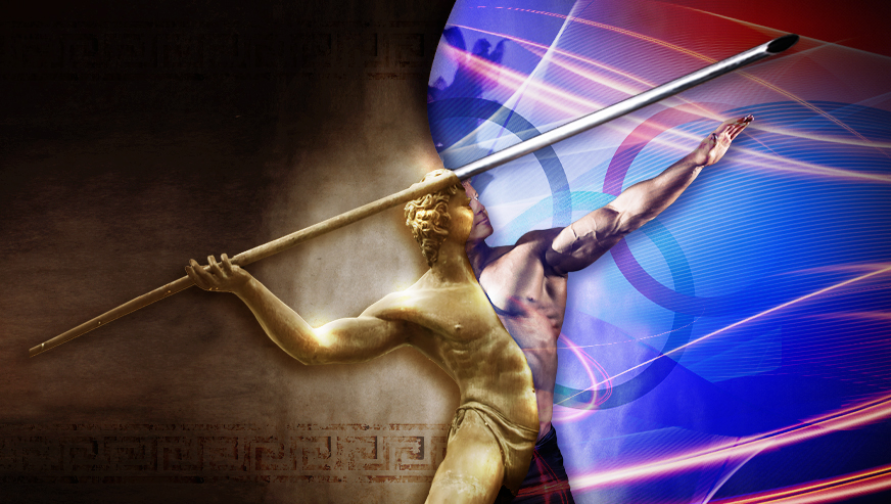
Nude competitors, chariot racing as a sport and potential death in combat matches—these are just a few ways the ancient Olympics differ from the global competition we know today. Zina Giannopoulou, associate professor of classics at UCI, dives deep into four ways today’s competition contrasts with its ancient predecessor.
Religion
The ancient Olympics were as much a religious festival as an athletic event. The first Olympics in recorded history, held in 776 B.C.E., included only one athletic competition: a 600-foot race, won by the cook Koroibos. The event was dedicated to Zeus, the chief Greek god. Up until 393 C.E., when the ancient Olympics were banned by the Roman emperor Theodosius I, athletes and spectators gathered in Olympia every four years (a cycle called “Olympiad”) to honor Zeus through sports, sacrifices, and hymns. By contrast, the modern Olympics, which began in 1896, are a secular event that promotes the host’s national and cultural identity in an international context.
Visual symbols of the Olympics
- The logo of five interlocking rings of the same diameter in blue, yellow, black, green, and red, which represents the five continents as a unity, was designed by Baron Pierre de Coubertin in 1913.
- A modern invention inspired by ancient Greek practices, the Olympic Torch Relay heralds the start of the Olympic Games and transmits the message of peace and friendship along its route. It was first performed in the 1936 Olympics in Berlin.
- The three medals were first awarded in the 1904 Olympics in St. Louis. Medals for each Olympic Game have their own distinctive design. Gold medals are at least 92.5% silver and must be coated with at least 6g of gold.
- The olive wreath (kotinos) is a branch of wild olive leaves from the sacred tree at Olympia, intertwined to form a circle. The kotinos is the main award to ancient Olympic victors.
The Athletes
Athletes (“competitors for a prize”) in ancient Olympics were amateurs since the Greeks thought that professionalism would be an unfair advantage over those who could not afford the luxury of full-time training. To erase social markers and promote ease of movement, ancient athletes competed in the nude (gymnast is derived from gymnos, which means “naked”). Until the 1970s, competition in the Olympic Games was reserved for amateurs, now defined as “athletes who do not get paid to perform their sport.” Over time, thanks to corporate endorsements and sponsorship, Olympic sports allowed for professionals to compete, including in boxing (since 2016).
The Prizes
Ancient Olympic victors were treated like heroes. They were crowned with the kotinos, wore ribbons around their arms and heads, and held palm branches. They were carried on strong shoulders around the stadium, amidst frenzied cheers, all the way to their city where they thanked the gods and participated in public feasts. Their city-state often paid for statues or portraits in their honor and gave them substantial material rewards. An Athenian winner, for example, would receive up to 500 drachmas, an ancient Greek currency, and free meals at the city hall for life, while other honors included a lifetime pension and special seats at public events. In modern Olympics, victors receive three medals – gold for the winner, silver for the first runner-up, and bronze for the second runner-up – which translate into cash prizes.
Fun facts
- The metal of each medal represents one of the Ages of Man in Greek mythology. Gods and mortals lived in peace and harmony during the golden age. Humans of the silver age were insolent and less noble than their golden age counterparts. Finally, the humans of the bronze age were prone to violence and carried armor forged of bronze.
- With 28, the American swimmer Michael Phelps holds the most Olympic medals to date. The record for the greatest number of medals held by a woman belongs to Larisa Latynina, a Soviet artistic gymnast, with 18.
- Winning athletes are often photographed biting their medals. This is usually done at the photographer’s request and is based on an old practice of biting into gold to test its purity and authenticity.
- The Olympic motto, “Faster, Higher, Stronger” (in Latin, “Citius, Altius, Fortius”), was the official motto of the Games since 1894. In response to the COVID-19 pandemic, the motto has been modified to “Faster, Higher, Stronger – Together.”
Values
For the ancient Greeks, athletic achievement was the highest manifestation of kalokagathia, the harmony of body and mind shown in physical beauty and virtuous behavior. Ancient Greek athletics gave to modern Olympics the idea that the virtues behind athletic excellence are more important than athletic excellence itself: athletes winning by unfair means were considered harmful to society, and now the medals of those competing on performance-enhancing drugs are revoked. The opportunity for athletes to display virtues like courage, perseverance, and self-sacrifice to large audiences, as well as their role in unifying communities and fans, has been a staple of the Olympics since antiquity. The Olympic Games are especially meaningful bearers of the virtues of athletic excellence, mutual respect, and solidarity. They remind us of our need to be inspired by those striving for greatness, and to celebrate them while being mindful of the fragility of human life itself.
To learn more about UCI’s Department of Classics, visit the website here.
